Optimization of 3D Printing Parameters for Enhanced Mechanical Strength: Effects of Glass Fiber Reinforcement and Fill Ratio Using RSM and ANOVA
Abstract
1. Introduction
2. Materials and Methods
2.1. Filament and Glass Fibers
2.2. Printing Process
2.3. Characterization
3. Experiment Design
4. Results and Discussion
4.1. Regression Analysis
- Source: Identify the factor or interaction being studied (e.g., individual factors and interactions).
- Squared sums: Calculates the total variance due to each source. The total of the squared discrepancies between observed values and the mean is calculated for each source.
- Define degrees of freedom (df): The number of independent variables in the analysis is indicated. It is determined by the number of elements and interactions under test.
- The Mean Square: Represents the average variance (variance) for each source, obtained by dividing the sum of squares by degrees.
- This formula examines the effect of each parameter based on its impact on the final model result.
4.2. Optimization Derived from Experimental Design
4.3. Fracture Surface Analysis
5. Conclusions
- Naturally, an infill of 50% results in lower production costs. However, using a higher infill percentage is better if the required criterion is the part’s strength. The impact of printing speed is significantly less compared to the other two variables.
- The highest force recorded was 540.65 N with a layer height of 0.5 mm, 100% infill, and a speed of 8 mm/s.
- The lowest force recorded was 389.93 N with a layer height of 0.4 mm, 50% infill, and a speed of 4 mm/s.
- After applying the transformation function, it is observed that the data align closely with the normal distribution line on the normal probability plot, indicating that the normal distribution is satisfied.
- Glass fibers have a significant impact on the strength of the samples in the printing process.
Author Contributions
Funding
Data Availability Statement
Conflicts of Interest
References
- Prem, P.R.; Sanker, A.P.; Sebastian, S.; Kaliyavaradhan, S.K. A review on application of acoustic emission testing during additive manufacturing. J. Nondestruct. Eval. 2023, 42, 96. [Google Scholar] [CrossRef]
- Vinogradov, P. 3D Printing in Medicine: Current Challenges and Potential Applications. In 3D Printing Technology in Nanomedicine; Elsevier Inc.: Maryland Heights, MO, USA, 2019; p. 1. [Google Scholar]
- Su, A.; Al’Aref, S.J. History of 3D Printing. In 3D Printing Applications in Cardiovascular Medicine; Academic Press: Cambridge, MA, USA, 2018; pp. 1–10. [Google Scholar]
- Pereira, A. Projeto de Estruturas Celulares Formadas por Rede de Treliças Baseado em Otimização Topológica: Modelagem, Manufatura Aditiva e Análise Experimental. Ph.D. Thesis, PUC-Rio, Rio de Janeiro, Brazil, 2023. [Google Scholar]
- Lim, S. Modeling curved-layered printing paths for fabricating large-scale construction components. Addit. Manuf. 2016, 12, 216–230. [Google Scholar]
- Monfared, V.; Bakhsheshi-Rad, H.R.; Ramakrishna, S.; Razzaghi, M.; Berto, F. A brief review on additive manufacturing of polymeric composites and nanocomposites. Micromachines 2021, 12, 704. [Google Scholar] [CrossRef]
- Castañares, M.S. Manufacturing Parameters Characterization of 3D Printer. Bachelor’s Thesis, Universitat Polytechnic de Catalonia, Barcelona, Spain, 2017. [Google Scholar]
- Khodadad Hatkeposhti, J.; Kordani, N.; Akbarzadeh Pasha, M.; Bodaghi, M. Brewing sustainability and strength: Biocomposite development through tea waste incorporation in polylactic acid. Proc. Inst. Mech. Eng. Part L J. Mater. Des. Appl. 2024, 238, 1289–1299. [Google Scholar] [CrossRef]
- Jayan, J.S.; Appukuttan, S.; Wilson, R.; Joseph, K.; George, G.; Oksman, K. An Introduction to Fiber Reinforced Composite Materials. In Fiber Reinforced Composites; Woodhead Publishing: Sawston, UK, 2021; pp. 1–24. [Google Scholar]
- Hensher, D.A. Fiber-Reinforced-Plastic (FRP) Reinforcement for Concrete Structures: Properties and Applications; Elsevier: Amsterdam, The Netherlands, 2016. [Google Scholar]
- Fateri, M.T.; Kordani, N.; Salavati, H.; Mohammadi Abokheili, R. Fracture assessment of inclined double keyhole notches in polylactic acid specimens fabricated by fused deposition modeling and traditional method. Polym. Eng. Sci. 2024, 64, 1521–1533. [Google Scholar] [CrossRef]
- Fu, Z.; Yao, Y.; Duan, Y.; Wang, B.; Li, X. Failure mechanism of bonding between natural fiber and cement matrix at high temperature. Constr. Build. Mater. 2024, 412, 134724. [Google Scholar] [CrossRef]
- Han, Z.; Fina, A. Thermal conductivity of carbon nanotubes and their polymer nanocomposites: A review. Prog. Polym. Sci. 2011, 36, 914–944. [Google Scholar] [CrossRef]
- Dadashi, A.; Bagheri, A.; Azadi, M.; Alizadeh, S.; Khatib, M.M. Investigating the delamination frequency in 3D-printed PLA-TPU bi-material composite structures under cyclic bending fatigue testing. Smart Mater. Methods 2024, 1, 224–250. [Google Scholar] [CrossRef]
- Bridarolli, A.; Nualart-Torroja, A.; Chevalier, A.; Odlyha, M.; Bozec, L. Systematic mechanical assessment of consolidants for canvas reinforcement under controlled environment. Herit. Sci. 2020, 8, 1–12. [Google Scholar] [CrossRef]
- Ozdemir, O.; Oztoprak, N.; Kandas, H. Single and repeated impact behaviors of bio-sandwich structures consisting of thermoplastic face sheets and different balsa core thicknesses. Compos. Part B Eng. 2018, 149, 49–57. [Google Scholar] [CrossRef]
- Ismail, K.I.; Pang, R.; Ahmed, R.; Yap, T.C. Tensile Properties of In Situ 3D Printed Glass Fiber-Reinforced PLA. Polymers 2023, 15, 3436. [Google Scholar] [CrossRef] [PubMed]
- Gray Iv, R.W.; Baird, D.G.; Bøhn, J.H. Thermoplastic composites reinforced with long fiber thermotropic liquid crystalline polymers for fused deposition modeling. Polym. Compos. 1998, 19, 383–394. [Google Scholar] [CrossRef]
- Zhong, W.; Li, F.; Zhang, Z.; Song, L.; Li, Z. Short fiber reinforced composites for fused deposition modeling. Mater. Sci. Eng. 2001, 29, 181–183. [Google Scholar] [CrossRef]
- Shofner, M.L.; Lozano, K.; Rodríguez-Macías, F.J.; Barrera, E.V. Nanofiber-reinforced polymers prepared by fused deposition modeling. J. Appl. Polym. Sci. 2003, 89, 3081–3090. [Google Scholar] [CrossRef]
- Tekinalp, H.L.; Kunc, V.; Velez-Garcia, G.M.; Duty, C.E.; Love, L.J.; Naskar, A.K.; Blue, C.A.; Ozcan, S. Highly oriented carbon fiber-polymer composites via additive manufacturing. Compos. Sci. Technol. 2014, 105, 144–150. [Google Scholar] [CrossRef]
- Wang, G.; Zhang, D.; Li, B.; Wan, G.; Zhao, G.; Zhang, A. Strong and thermal-resistance glass fiber-reinforced polylactic acid (PLA) composites enabled by heat treatment. Int. J. Biol. Macromol. 2019, 129, 448–459. [Google Scholar] [CrossRef]
- Centola, M.; Rainer, A.; Spadaccio, C.; De Porcellinis, S.; Genovese, J.A.; Trombetta, M. Combining electrospinning and fused deposition modeling for the fabrication of a hybrid vascular graft. Biofabrication 2010, 2, 014102. [Google Scholar] [CrossRef]
- Chokshi, S.; Gohil, P. Experimental Investigation and Mathematical Modeling of Longitudinally Placed Natural Fiber Reinforced Polymeric Composites Including Interphase Volume Fraction. Fibers Polym. 2022, 23, 488–501. [Google Scholar] [CrossRef]
- Aliheidari, N.; Christ, J.; Tripuraneni, R.; Nadimpalli, S.; Ameli, A. Interlayer adhesion and fracture resistance of polymers printed through melt extrusion additive manufacturing process. Mater. Des. 2023, 156, 351–361. [Google Scholar] [CrossRef]
- Wen, C. Influence of fibers on the mechanical properties and durability of ultra-high-performance concrete: A review. J. Build. Eng. 2022, 52, 104370. [Google Scholar] [CrossRef]
- Zhang, J. Silk particles, microfibres and nanofibres: A comparative study of their functions in 3D printing hydrogel scaffolds. Mater. Sci. Eng. C 2019, 103, 109784. [Google Scholar] [CrossRef]
- Ghaly, A.A.; Abou-Zeid, M.N. Thermal insulation and fire protection plaster for FRP systems incorporating aerogel nanoparticles and phyllosilicates. Constr. Build. Mater. 2024, 449, 138475. [Google Scholar] [CrossRef]
- Dhanola, A. Influence of natural fillers on physico-mechanical properties of luffa cylindrical/polyester composites. Mater. Today: Proc. 2018, 5, 17021–17029. [Google Scholar]
- Mohammadi Abokheili, R.; Kordani, N.; Aghajani Derazkola, H.; Nejadali, J. Experimental investigation of the polymer-metal hybrids interfacial bonding fabricated by fused deposition modeling. Proceed. Instit. Mech. Eng. Part L 2025, 239, 127–137. [Google Scholar]
- Jogur, G.; Das, A.; Alagirusamy, R. Development of Kevlar®/polypropylene towpregs through optimized commingling nozzle and processing parameters for thermoplastic composites. J. Thermoplast. Compos. Mater. 2023, 36, 4162–4188. [Google Scholar] [CrossRef]
- Yoo, D.-Y.; Banthia, N. Mechanical properties of ultra-high-performance fiber-reinforced concrete: A review. Cem. Concr. Compos. 2016, 73, 267–280. [Google Scholar] [CrossRef]



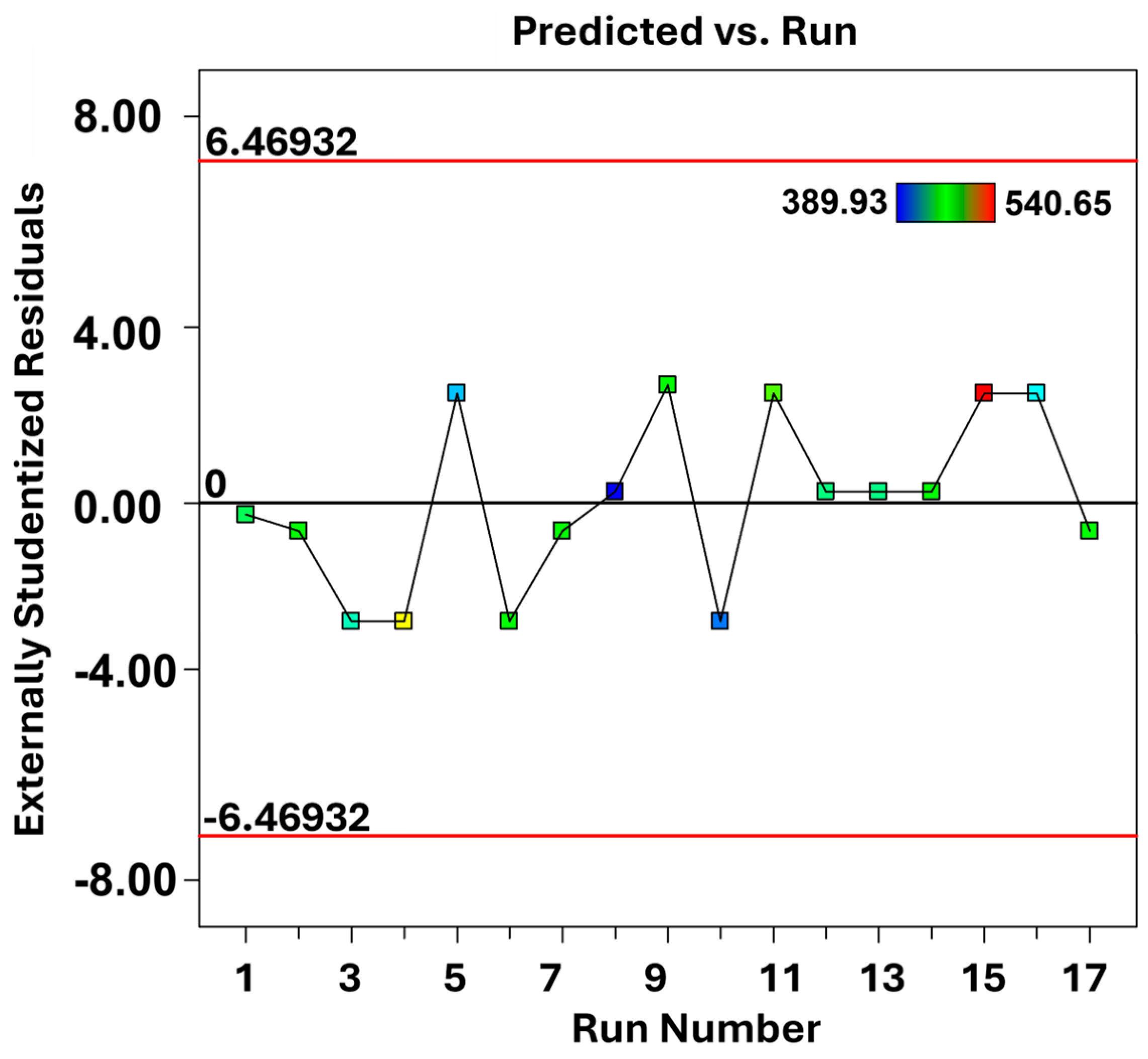

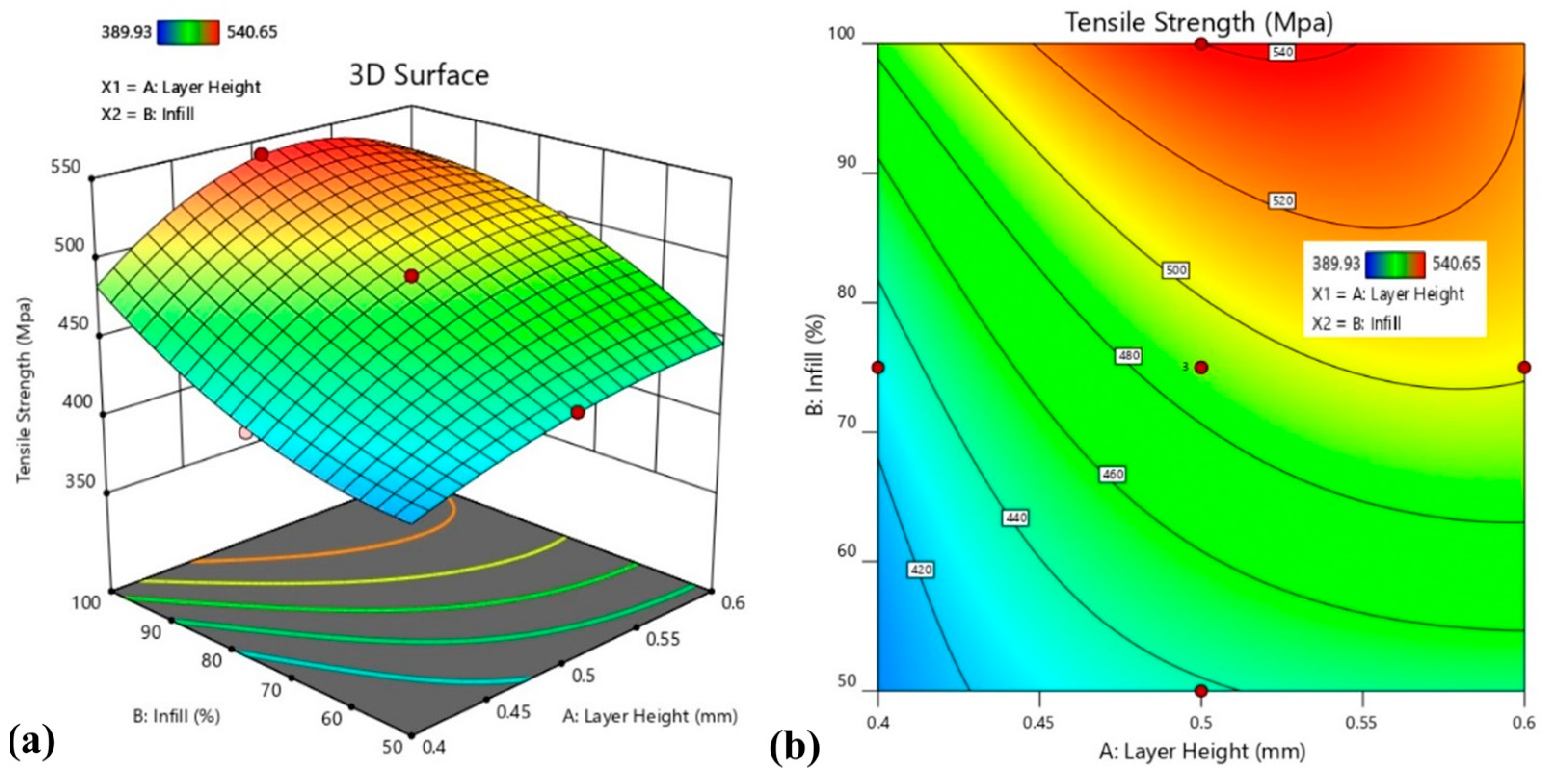


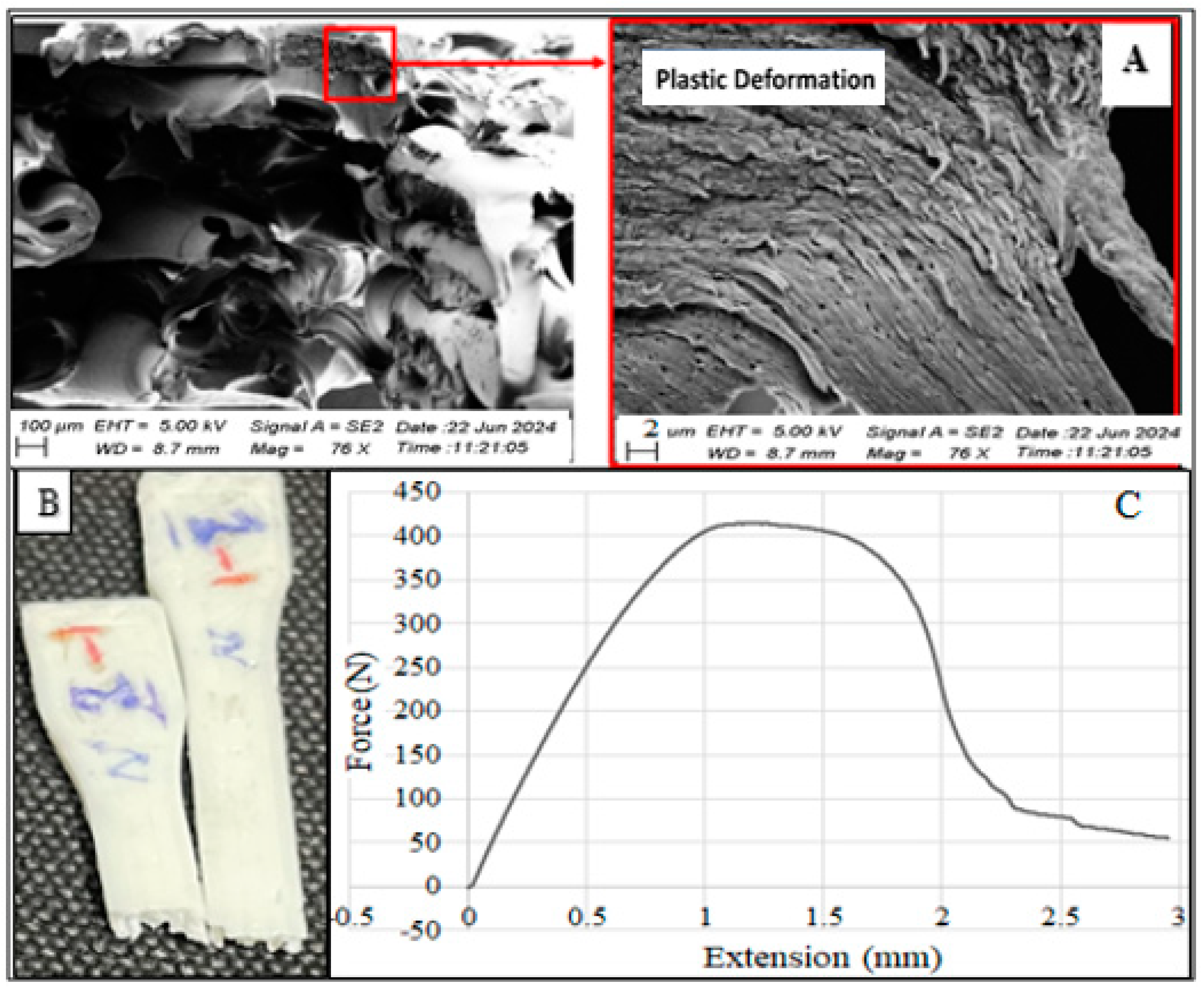
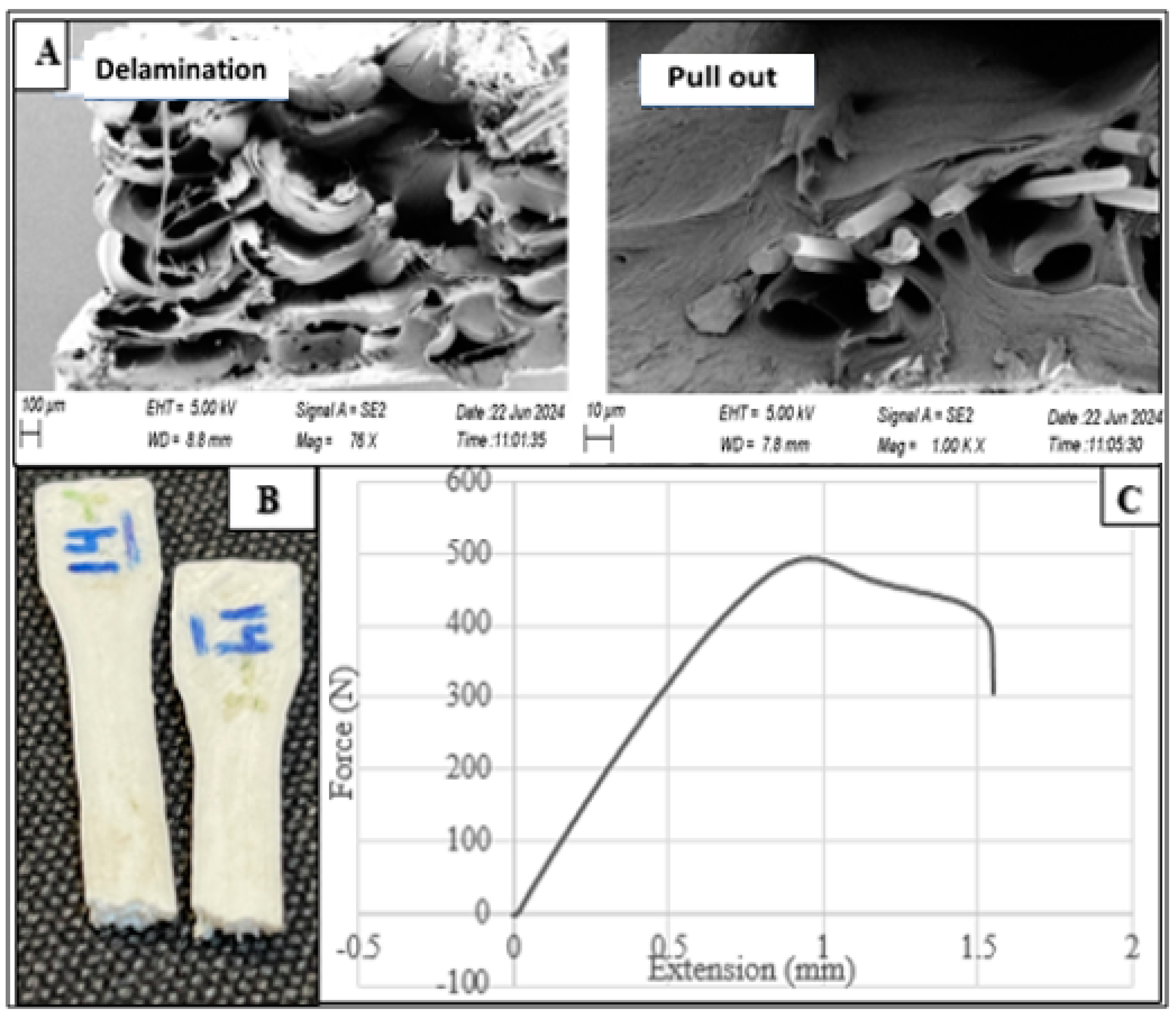

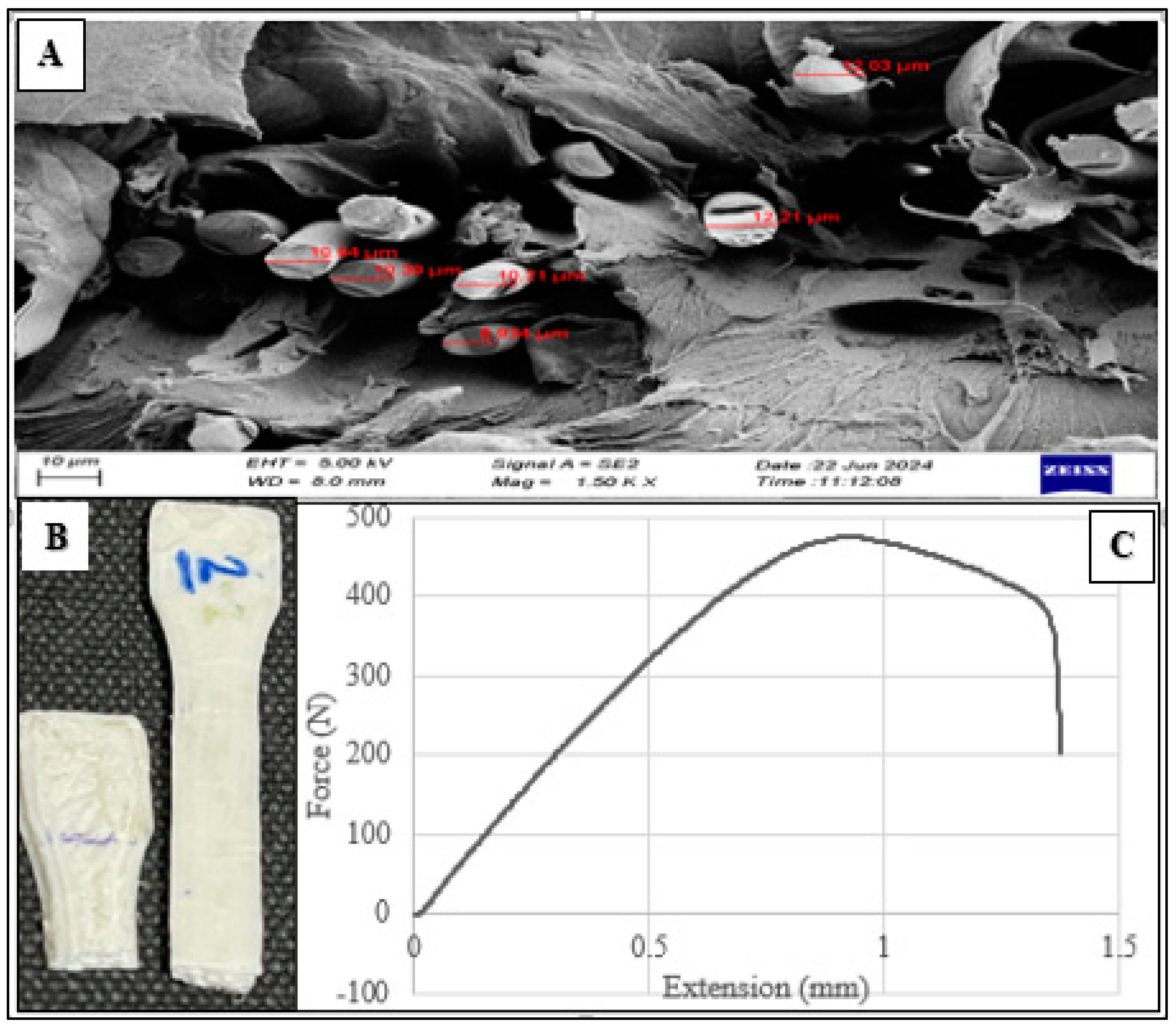
| Layer Height [mm] | Infill [%] | Speed [mm/s] | |
|---|---|---|---|
| 1 | 0.4 | 50 | 4 |
| 2 | 0.5 | 75 | 8 |
| 3 | 0.6 | 100 | 12 |
| Run | Layer Height (mm) | Infill (%) | Speed (mm/s) | Tensile Strength (Mpa) |
|---|---|---|---|---|
| 1 | 0.5 | 75 | 8 | 466.6 |
| 2 | 0.5 | 75 | 12 | 490.1 |
| 3 | 0.4 | 50 | 12 | 426.3 |
| 4 | 0.6 | 100 | 12 | 532.8 |
| 5 | 0.4 | 75 | 8 | 426.33 |
| 6 | 0.4 | 100 | 12 | 476.2 |
| 7 | 0.5 | 75 | 8 | 490.1 |
| 8 | 0.4 | 50 | 4 | 389.93 |
| 9 | 0.5 | 75 | 12 | 497.43 |
| 10 | 0.6 | 50 | 12 | 424.3 |
| 11 | 0.6 | 75 | 8 | 499.06 |
| 12 | 0.4 | 100 | 4 | 479.86 |
| 13 | 0.6 | 50 | 4 | 459.4 |
| 14 | 0.6 | 100 | 4 | 503.35 |
| 15 | 0.5 | 100 | 8 | 540.65 |
| 16 | 0.5 | 50 | 8 | 438.6 |
| 17 | 0.5 | 75 | 8 | 490.1 |
| Run | Process Variable | Operating Condition |
|---|---|---|
| 1 | Nozzle Diameter | 1 mm |
| 2 | Filament Diameter | 1.75 mm |
| 3 | Layer Height | 0.4–0.5–0.6 mm |
| 4 | Speed | 4–8–12 mm/s |
| 5 | Solid Layers | Top—1, Bottom—1, Shell—2 |
| 6 | Infill | 50–75–100% |
| 7 | Fill Density | 1.25 gr/cm3 |
| 8 | Internal Fill Pattern | Rectilinear |
| 9 | Perimeter Speed | 50 mm/s |
| 10 | Infill Speed | 60 mm/s |
| 11 | Travel Speed | 80 mm/s |
| 12 | Nozzle Temperature | PLA–210 °C |
| 13 | Bed Temperature | PLA–55 °C |
| 14 | Horizontal | |
| 15 | Sample length | mm (according to the map) Figure 1 |
| Source | Sum of Squares | Degrees of Freedom (df) | Mean Square | F-Value | p-Value | |
|---|---|---|---|---|---|---|
| Model | 26,264.75 | 11 | 2387.70 | 220.12 | <0.0001 | Significant |
| A-Layer Height | 2644.83 | 1 | 2644.83 | 243.83 | <0.0001 | |
| B-Infill | 5207.10 | 1 | 5207.10 | 480.05 | <0.0001 | |
| C-speed | 475.24 | 1 | 475.24 | 43.81 | 0.0012 | |
| AC | 183.94 | 1 | 183.94 | 16.96 | 0.0092 | |
| BC | 75.15 | 1 | 75.15 | 6.93 | 0.0464 | |
| A2 | 1696.26 | 1 | 1696.26 | 156.38 | <0.0001 | |
| C2 | 57.21 | 1 | 57.21 | 5.27 | 0.0701 | |
| ABC | 1367.12 | 1 | 1367.12 | 126.04 | <0.0001 | |
| A2B | 335.94 | 1 | 335.94 | 30.97 | 0.0026 | |
| A2C | 231.65 | 1 | 231.65 | 21.36 | 0.0057 | |
| AB2 | 513.80 | 1 | 513.80 | 47.37 | 0.0010 | |
| Residual | 54.24 | 5 | 10.85 | |||
| Lack of Fit | 54.24 | 3 | 18.08 | Not Significant | ||
| Pure Error | 0.0000 | 2 | 0.0000 | |||
| Cor Total | 26,318.98 | 16 |
| Std. Dev. | 3.29 |
| Mean | 472.42 |
| C.V. % | 0.6972 |
| R2 | 0.9979 |
| Adjusted R2 | 0.9934 |
| Predicted R2 | 0.9250 |
| Adeq Precision | 55.0046 |
Disclaimer/Publisher’s Note: The statements, opinions and data contained in all publications are solely those of the individual author(s) and contributor(s) and not of MDPI and/or the editor(s). MDPI and/or the editor(s) disclaim responsibility for any injury to people or property resulting from any ideas, methods, instructions or products referred to in the content. |
© 2025 by the authors. Licensee MDPI, Basel, Switzerland. This article is an open access article distributed under the terms and conditions of the Creative Commons Attribution (CC BY) license (https://creativecommons.org/licenses/by/4.0/).
Share and Cite
Jawad, H.H.; Kordani, N.; Bagheri, A.; Derazkola, H.A. Optimization of 3D Printing Parameters for Enhanced Mechanical Strength: Effects of Glass Fiber Reinforcement and Fill Ratio Using RSM and ANOVA. J. Compos. Sci. 2025, 9, 63. https://doi.org/10.3390/jcs9020063
Jawad HH, Kordani N, Bagheri A, Derazkola HA. Optimization of 3D Printing Parameters for Enhanced Mechanical Strength: Effects of Glass Fiber Reinforcement and Fill Ratio Using RSM and ANOVA. Journal of Composites Science. 2025; 9(2):63. https://doi.org/10.3390/jcs9020063
Chicago/Turabian StyleJawad, Hussein Hadi, Naser Kordani, Abbasali Bagheri, and Hamed Aghajani Derazkola. 2025. "Optimization of 3D Printing Parameters for Enhanced Mechanical Strength: Effects of Glass Fiber Reinforcement and Fill Ratio Using RSM and ANOVA" Journal of Composites Science 9, no. 2: 63. https://doi.org/10.3390/jcs9020063
APA StyleJawad, H. H., Kordani, N., Bagheri, A., & Derazkola, H. A. (2025). Optimization of 3D Printing Parameters for Enhanced Mechanical Strength: Effects of Glass Fiber Reinforcement and Fill Ratio Using RSM and ANOVA. Journal of Composites Science, 9(2), 63. https://doi.org/10.3390/jcs9020063






